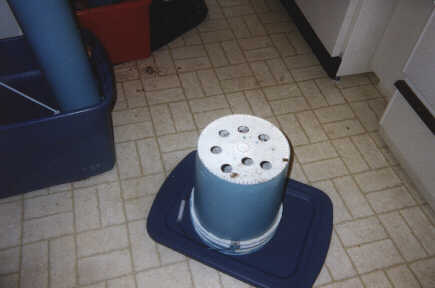709-218-7927 The Landfall Garden House 60 Canon Bayley Road CANADA A0C 1B0 |
|---|
Vermicomposting in the cold-climate apartment - Construction
Material
Being cheap by nature, I hit on the idea of using the 20-litre plastic tubs discarded by most restaurants. Right there on the kerb, with the garbage, one can collect these sturdy plastic tubs with handles, and with the lids.
Alternate source of tubs: I get my ice-cream in 15-litre pails direct from the factory. These pails are slightly less robust, but they'll do. You can use them, too, as holders for larger house- plants.
The tubs from restaurants are 20L, about 15" high about 10" diameter. The ice-cream tubs are more like 11L 25 cm diameter and 30 cm high.
Materials and tools for those who want to take an active part:
- 25-litre pails (with lid and handle)
- Planks (separators)
- Margarine containers (for transporting soil & worms)
- Garbage bags (floor covering, carrier)
- Shears (for cutting pail lids)
- Paint and brush (for decorating the pails)
Assembly
Lids: Trim the beading from the lid. This gives you a sturdy circular flange, about 3/4 inch wide and deep. Cut the beading into three equal-length segments. In the flat platter that's left, drill or cut or saw holes about one-inch diameter to make a perforated drainage plate.
Tubs: Across the base, drill or cut or saw holes about one-inch diameter to make a perforated base, just like the plate.

View of the underside of either the base pail from the tower, or any one of the serial design. The holes were made with a power-drill with a cylindrical saw attachment. Holes could be rectangular, or triangular, providing that they permit egress of superfluous fluids.
Place the three segments of beading in the tub, curved side inwards, so that they make a triangular stand for the plate.
Labels
I use stout masking tape to fix half-envelopes to the sides of the bin. The envelopes are a pouch into which I slip a piece of paper bearing the bin's load date.
Chest of drawers
Wednesday, August 21, 2002
I’ve not tried this, but it should work. I’ve seen web sites suggesting that a wooden drawer from a chest of drawers would make a great bin. I’ve been using vegetable trays from discarded refigerators, but still.
It struck me that one could build a “vermicondominium” by using the entire chest of drawers. In my bedroom I have two chests, one with four drawers at 24”x7” (internal), and one with eight drawers all 7” deep and varying widths from 10” to 24”.
No, I’m not going to store my clothes and linen on the floor, but either one of these would allow a household to build one bin with daily wastes until the bin was full, and then start filling the next drawer, allowing the first drawer to mature until the last drawer was filled.
At that time the first drawer can be harvested and re-bedded.
The volume is typically 9,000 cubic inches or about 30 Canadian gallons.
If you are considering setting up a system for a household – large volume waste to be processed in as small an area as possible, you may want to calculate the space efficiency of the unit.
Below is a table with sample entries for two chests of drawers, a series of pails stacked vertically, a school-size plastic bin and a tower composter made from a discarded length of galvanised steel chimney pipe (from the old furnace in our apartment building).
To calculate the effiency, calculate the volume available for composting (e.g. the sum of all the drawers in a chest of drawers) and calculate the area occupied by the unit (e.g. the area of the chest of drawers), then divide the volume by the area. The ratio of “volume to area” gives you a measure of how much volume for composting your are obtaining from your space allocated for the unit.
My preliminary figures suggest that chests of drawers are excellent, the chimney tower is good, but my system of stacked pails is a very poor use of space.
Note that for the tower composters I have doubled the footprint, because I usually place the tower in a refrigerator drawer as wide as the pails but twice as long (to allow for the soil to spil out into an enclosed area). It’s true that when a drawer is opened you need extra space, but that space is not occupied permanently.
Number |
Width/Radius |
Depth |
Height |
Area |
Volume |
Ratio |
|
|---|---|---|---|---|---|---|---|
Tallboy Chest of Drawers |
|||||||
Footprint |
27.5 |
16.5 |
453.8 |
||||
Bins |
4 |
24 |
13 |
7 |
8,736.0 |
19.3 |
|
Bencher Chest of Drawers |
|||||||
Footprint |
27.5 |
16.5 |
453.8 |
||||
Bins |
2 |
24 |
13 |
5 |
3,120.0 |
||
4 |
18 |
13 |
5 |
4,680.0 |
|||
2 |
10 |
13 |
5 |
1,300.0 |
|||
9,100.0 |
20.1 |
||||||
4-pail tower (4 of my 25Litre pails, stacked vertically) |
|||||||
Footprint |
12 |
24 |
288.0 |
||||
Bins |
4 |
5.5 |
15 |
95.1 |
1,426.1 |
5.0 |
|
School-size http://www.vermitechnology.com/worm_feed_bins.html |
|||||||
Footprint |
22 |
14 |
308.0 |
||||
Bins |
21 |
13 |
12.5 |
3,412.5 |
11.1 |
||
Chimney tower (galvanised steel) |
|||||||
Footprint |
20 |
40 |
800 |
||||
Bins |
1 |
9 |
48 |
254.6 |
12,219.4 |
15.3 |
Loading
709 218 7927 CPRGreaves@gmail.com
Bonavista, Wednesday, June 03, 2020 12:27 PM
Copyright © 1996-2020 Chris Greaves. All Rights Reserved.